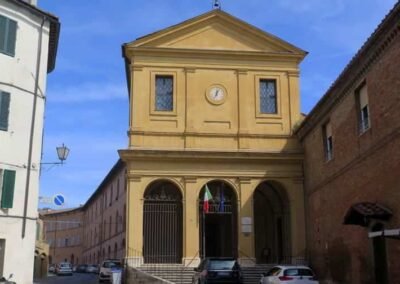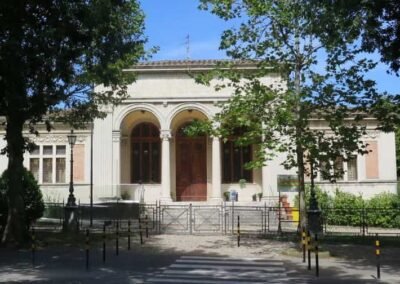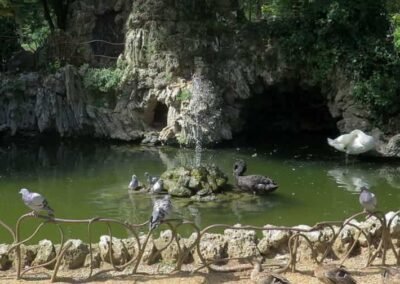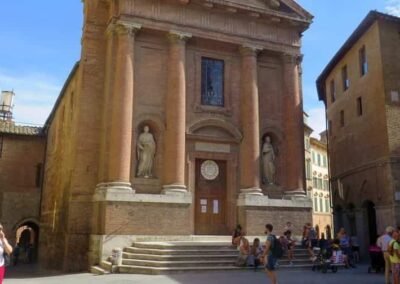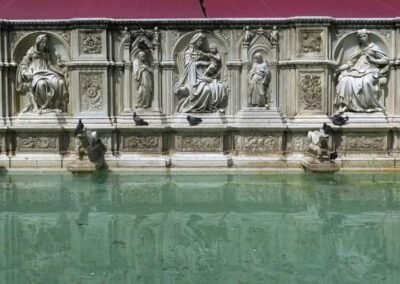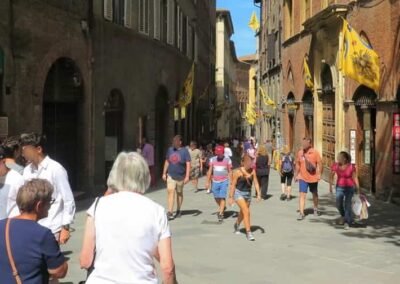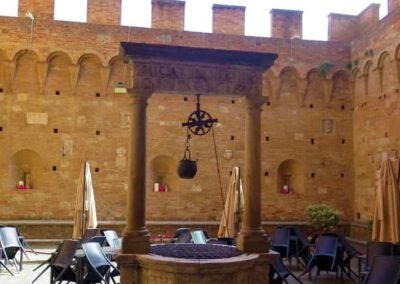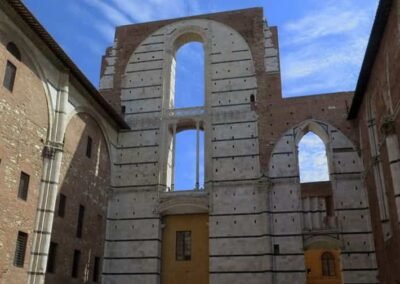HOME
THE REGIONS OF ITALY
PLACES IN ITALY
Italy in Photos
Piazza del Campo, 53100 Siena, Italy (September 2018)
Siena
Siena, a stunning hilltop city located in the heart of Tuscany, Italy, is known for its well-preserved medieval architecture, rich history, and vibrant cultural traditions. Often regarded as one of the most beautiful cities in Italy, Siena is a UNESCO World Heritage Site that captures the essence of medieval Italy. Its winding, narrow streets, breathtaking piazzas, and Gothic landmarks transport visitors back to a time of powerful city-states, when Siena was a thriving centre of commerce, culture, and art. At the heart of Siena lies the Piazza del Campo, one of the most famous medieval squares in Europe and the city’s beating heart. Shaped like a shell, this unique piazza is the centre of social life in Siena, framed by beautiful buildings, cafes, and restaurants. Dominating the square is the Torre del Mangia, a towering medieval bell tower that offers stunning views of the city and surrounding Tuscan countryside. Adjacent to the tower is the Palazzo Pubblico, Siena’s Gothic town hall, which has been the centre of Sienese government since the 14th century. Inside, visitors can admire frescoes by renowned artists, including Ambrogio Lorenzetti’s famous “Allegory of Good and Bad Government”, a masterpiece of early Renaissance art. Siena is perhaps most famous for its biannual horse race, the Palio di Siena, held in the Piazza del Campo every July 2nd and August 16th. This thrilling and fiercely competitive event, dating back to the Middle Ages, sees ten riders representing different neighbourhoods, or contrade, race bareback around the piazza. The Palio is more than just a race—it is a deep-rooted tradition and source of pride for the Sienese people. Visitors who witness the Palio not only experience the race itself but also the vibrant parades, historic costumes, and the passion of a city that lives and breathes this centuries-old tradition.
One of Siena’s most iconic landmarks is the Siena Cathedral (Duomo di Siena), a masterpiece of Gothic architecture and one of the most beautiful churches in Italy. The cathedral’s striking black-and-white striped marble façade and ornate interior are awe-inspiring. Inside, visitors are greeted by stunning works of art, including the intricate mosaic floors, sculptures by Michelangelo, and the exquisite Piccolomini Library, decorated with vibrant frescoes by Pinturicchio. The cathedral also houses the Museo dell’Opera del Duomo, which showcases treasures of religious art and offers access to a panoramic viewpoint with breathtaking views of the city. Siena’s rich cultural history is closely tied to its status as a centre of learning and art during the Middle Ages and Renaissance. The city’s historic university, founded in 1240, is one of the oldest in Europe and continues to play an important role in academic life. Additionally, Siena has been home to some of Italy’s greatest artists and thinkers, including Simone Martini, Duccio, and Saint Catherine of Siena, one of Italy’s two patron saints. Beyond its famous landmarks and historical significance, Siena offers a unique Tuscan charm with its relaxed pace of life and focus on tradition. The city is surrounded by the picturesque Tuscan countryside, with rolling hills, vineyards, and olive groves that produce some of Italy’s finest wines and olive oils. The local cuisine reflects this heritage, with dishes like pici (hand-rolled pasta), ribollita (Tuscan vegetable soup), and panforte (a traditional fruit and nut cake) showcasing the flavours of the region. Siena is a city that combines history, art, and tradition in a way that few other places can. Whether you are exploring its medieval streets, visiting its majestic cathedral, or witnessing the Palio, Siena offers an unforgettable journey through the
Worth a Visit

The Church of Santa Maria in Portico a Fontegiusta is a Renaissance jewel located on Via di Fontegiusta in Siena, Italy. Built between 1482 and 1484, it was commissioned to commemorate the Sienese victory over Florence at the Battle of Poggio Imperiale in 1479. The design is attributed to Francesco di Giorgio Martini, one of Siena’s most important Renaissance architects, and the church reflects his refined classical style. The façade, completed later in the 16th century, presents elegant proportions in travertine. Inside, visitors can admire works by notable artists such as Francesco Vanni, Bernardino Fungai, and Ventura Salimbeni, alongside a graceful marble altar. Particularly striking are the frescoes and the harmonious atmosphere created by the bright interior. The church is a quiet yet culturally rich stop, often overlooked compared to Siena’s cathedral, but it offers an intimate glimpse into the city’s artistic and spiritual heritage.

Giardini la Lizza is a charming public garden located along Viale Rinaldo Franci, just outside Siena’s historic city walls. Once part of the city’s medieval fortifications, the area was transformed into a green space in the 19th century and today serves as one of Siena’s most popular urban parks. The gardens offer a peaceful retreat from the bustling streets, with tree-lined avenues, wide lawns, and shaded benches that make it an inviting place for relaxation. A central feature is the monument to Giuseppe Garibaldi, the Italian national hero, which adds historical significance to the setting. The park is also a lively spot for cultural events, open-air markets, and seasonal fairs, attracting both locals and visitors. Conveniently located near the Medicean Fortress and the Stadio Artemio Franchi, Giardini la Lizza provides a pleasant blend of leisure, history, and community life within walking distance of Siena’s city centre.

Piazza del Campo is the heart of Siena and one of the most famous medieval squares in Europe. Renowned for its unique shell shape and harmonious design, it has been the city’s social, political, and cultural centre since the Middle Ages. Surrounded by elegant palazzi, the square is dominated by the Palazzo Pubblico with its tall Torre del Mangia, offering breath-taking views over Siena and the Tuscan countryside. At its centre stands the Fonte Gaia, a monumental fountain that symbolizes prosperity and civic pride. Piazza del Campo is world-famous for hosting the Palio di Siena, a thrilling horse race held twice a year, which transforms the square into a vibrant stage of tradition, rivalry, and celebration. Today, visitors can enjoy cafés and restaurants lining the square, making it a lively gathering place. Piazza del Campo is not only Siena’s heart but also a masterpiece of urban planning and civic identity.

Piazza del Duomo is one of Siena’s most evocative and historically rich squares, located in the heart of the city. It is best known as the setting of the magnificent Siena Cathedral (Duomo di Santa Maria Assunta), a masterpiece of Italian Gothic architecture. The piazza is framed by important buildings such as the Museo dell’Opera del Duomo, housing precious artworks, and the Baptistery of San Giovanni, with its stunning Renaissance decorations. Here, visitors can admire the striking black-and-white striped marble of the cathedral’s façade, designed by Giovanni Pisano, and the impressive marble steps that lead into the church. The square has long been a hub of religious and civic life, embodying Siena’s devotion, artistic heritage, and sense of grandeur. Today, Piazza del Duomo remains a vibrant place where history, art, and spirituality come together, offering travellers a chance to experience the city’s cultural soul in an unforgettable setting.
Photo Gallery of Walk 1 – Stazione Ferroviaria Siena to Giardini la Lizza
Approximately 1.85 km – 1.15 miles
The walk starts at Stazione Ferroviaria Siena – Enter the Shopping Centre opposite and ascend using the escalators and travelators to Viale Vittorio Emanuele II – Viale Camillo Benso di Cavour – Parrocchia S. Petronilla walk back to Viale Vittorio Emanuele II – Porta Camollia – Piazza Guido Chigi Saracini – Via Campansi – Via Camollia – San Pietro Alla Magione, Via Camollia – Via Di Fontegiusta – Chiesa di Santa Maria in Portico a Fontegiusta – walk back to Via Camollia – Via Campansi – Via dei Montanini – Chiesa di Sant’Andrea, Via dei Montanini – Via Sasso di S. Bernardino – Piazza Antonio Gramsci – Giardini la Lizza
Photo Gallery of Walk 2 – Piazza Antonio Gramsci to Via di Città
Approximately 1.41 km – 0.88 miles
The walk starts in Piazza Antonio Gramsci – Via Sasso di S. Bernardino – Via dei Montanini – Piazza Salimbeni – Via dei Montanini – Piazza Tolomei – Via Cecco Angiolieri – Piazza Tolomei – Via Banchi di Sopra – Vicolo S. Pietro – Piazza del Campo – Costa Barbieri – Via di Città – Fondazione Accademia Musicale Chigiana – Onlus, Via di Città – Via di Città – Via del Castoro – Piazza Jacopo della Quercia – Piazza del Duomo – Via del Capitano – Via di Città
COPYRIGHT © 2018-2025 ITALY IN PHOTOS - ALL RIGHTS RESERVED
























